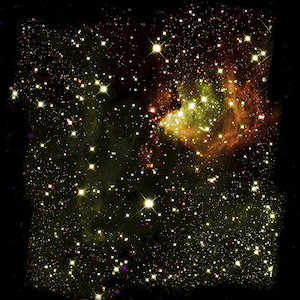Science
Related: About this forumCosmic 'fireworks' shine in baby star cluster and distant galaxy
By Meghan Bartels 8 hours ago

An animation shows a background infrared
image captured by the Hubble Space
Telescope with a purple burst above showing
gas in the cluster speeding toward the sun.
(Image: © ALMA (ESO/NAOJ/NRAO), Y. Cheng et al.; NRAO/AUI/NSF, S. Dagnello; NASA/ESA Hubble)
A high-powered telescope array has caught the brilliant fireworks-like "streamers" of gas formed during an early stage of star development in a giant cluster.
That process may take a million years to complete, according to scientists who captured a new look at the star cluster formally known as G286.21+0.17. To image the star cluster in all its glory, the astronomers used two different instruments: the Hubble Space Telescope, which provided a look at the existing stars in the cluster, and the Atacama Large Millimeter/submillimeter Array (ALMA) in Chile, which provided a look at the gas falling inward to form future stars.
"This illustrates how dynamic and chaotic the process of star birth is," co-author Jonathan Tan of Chalmers University in Sweden and the University of Virginia, said in a statement. "We see competing forces in action: gravity and turbulence from the cloud on one side, and stellar winds and radiation pressure from the young stars on the other."
"This process sculpts the region," Tan said in the statement. "It is amazing to think that our own sun and planets were once part of such a cosmic dance."
More:
https://www.space.com/celestial-fireworks-star-cluster-galaxy-photos-2020.html?utm_source=notification
Judi Lynn
(160,527 posts)Stellar fireworks celebrate the birth of giant clusters.
BY
AMIT MALEWAR
JULY 3, 2020

Image of star cluster G286.21+0.17, caught in the act of formation. This is a multiwavelength mosaic of more
than 750 ALMA radio images, and 9 Hubble infrared images. ALMA shows molecular clouds (purple) and Hubble
shows stars and glowing dust (yellow and red). Credit: ALMA (ESO/NAOJ/NRAO), Y. Cheng et al.; NRAO/AUI/NSF,
S. Dagnello; NASA/ESA Hubble.
Most of the massive stars in the universe were originated in enormous star clusters. These clusters are the building blocks of galaxies, but their formation from dense molecular clouds remains obscure.
Now, astronomers have created a stunning image showing celestial fireworks in star cluster G286.21+0.17 that is located in the Carina region of our galaxy, about 8000 light-years away. The cluster was caught in the act of formation.
Astronomers created a multi-wavelength mosaic made out of more than 750 individual radio observations with the Atacama Large Millimeter/submillimeter Array (ALMA) and nine infrared images from the NASA/ESA Hubble Space Telescope.
The telescope observed the motions of turbulent gas falling into the cluster, forming dense cores that ultimately create individual stars.
Yu Cheng of the University of Virginia in Charlottesville, Virginia, said, “This image shows stars in various stages of formation within this single cluster.”
More:
https://www.techexplorist.com/stunning-new-image-star-cluster/33490/